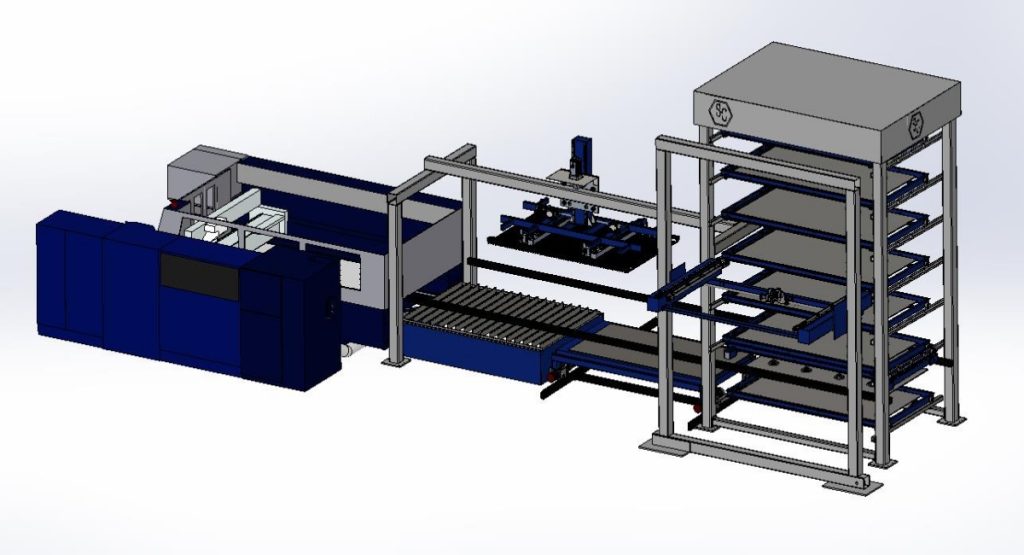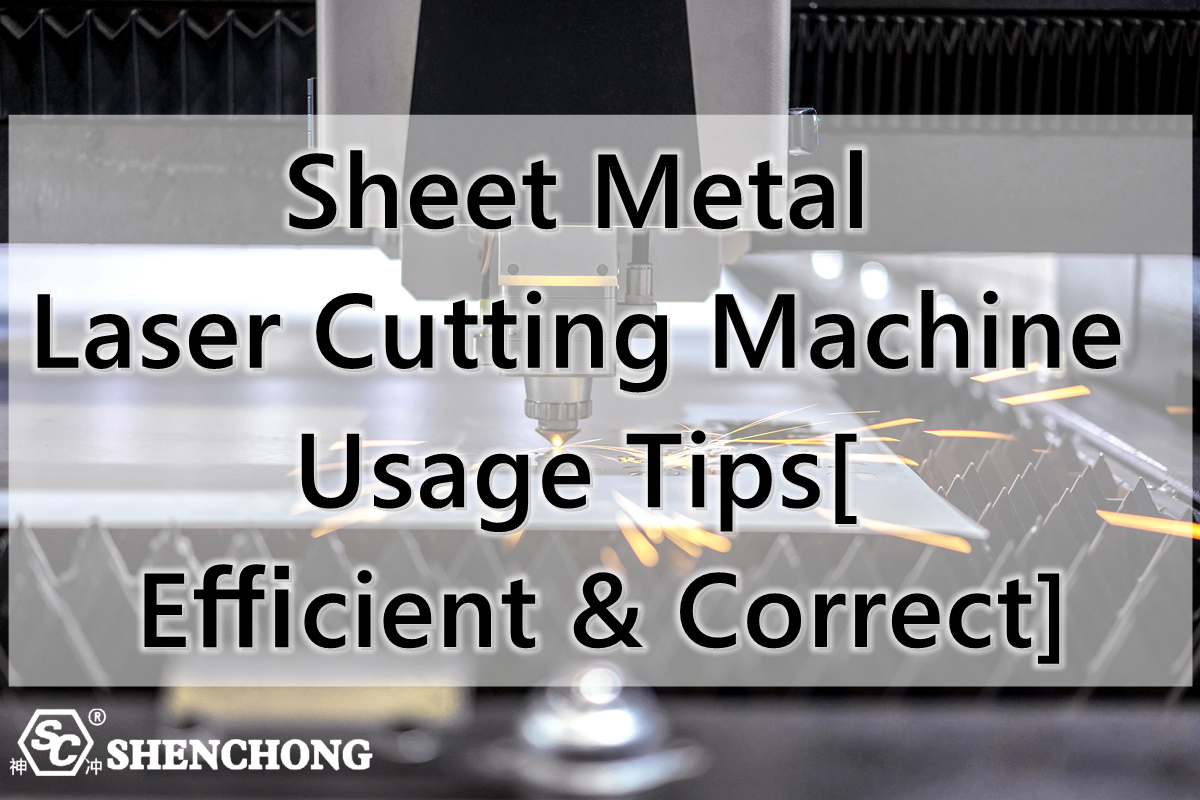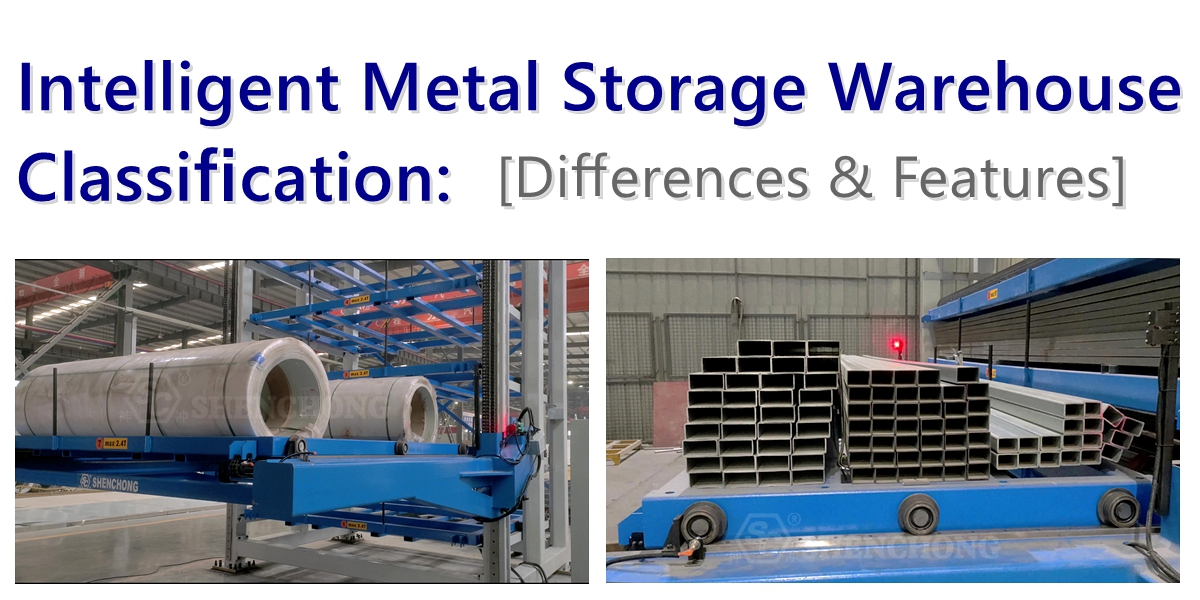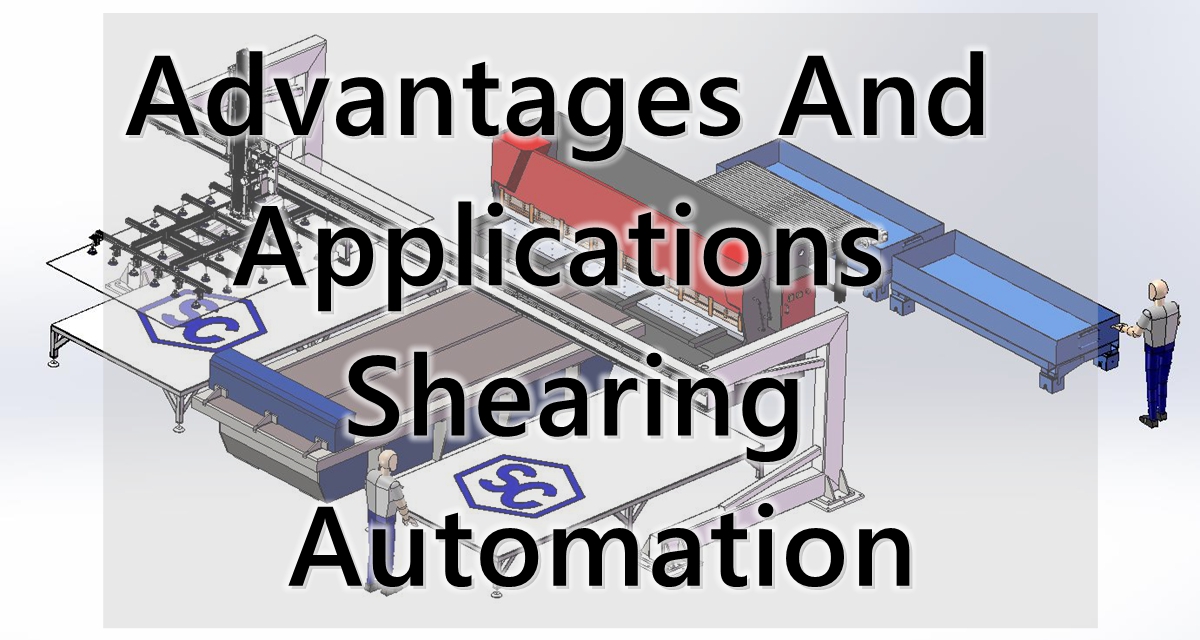Table of Contents
Introduction
Metal automation loading and unloading system is the revolution equipment to automatic move the sheet metal plates from one machine to another. The most popular application of the automatic loading unloading system is for laser cutting machine.
Laser cutting machines have revolutionized the manufacturing industry by providing precision, speed, and versatility in cutting various materials. However, to fully leverage the capabilities of these machines, efficient material handling systems are crucial. Loading and unloading systems for laser cutting machines play a vital role in enhancing productivity, reducing downtime, and ensuring safety. This article delves into the different types of loading and unloading systems, their benefits, applications, and future trends, providing a comprehensive overview of these essential components in laser cutting operations.
The Importance of Metal Automation Loading and Unloading System
Loading and unloading systems are designed to automate the process of supplying raw materials to the laser cutting machine and removing finished parts. These systems are essential for several reasons:
- Increased Productivity: Automated systems can significantly reduce the time required to load and unload materials, allowing the laser cutting machine to operate continuously and efficiently.
- Reduced Labor Costs: By automating these processes, manufacturers can minimize the need for manual labor, reducing labor costs and the potential for human error.
- Improved Safety: Automated systems enhance workplace safety by minimizing the need for human intervention in potentially hazardous operations.
- Consistency and Quality: Automation ensures consistent handling of materials, which contributes to maintaining high-quality standards in the cutting process.
Applications of Loading and Unloading Systems
1. Automotive Industry
In the automotive industry, loading and unloading systems are used to handle large sheets of metal and complex parts. Automated systems ensure consistent quality and high productivity, meeting the demands of mass production.
2. Aerospace Industry
The aerospace industry requires precision and consistency in the manufacturing of components. Automated loading and unloading systems help achieve these requirements by ensuring accurate material handling and reducing the risk of defects.
3. Metal Fabrication
Metal fabrication involves cutting, shaping, and assembling metal parts. Loading and unloading systems streamline these processes by automating the handling of raw materials and finished parts, increasing efficiency and productivity.
4. Electronics Industry
In the electronics industry, precision is paramount. Automated systems ensure the accurate handling of delicate materials and components, minimizing the risk of damage and ensuring high-quality production.
5. Furniture Manufacturing
The furniture manufacturing industry benefits from automated systems that handle large sheets of wood, metal, or composite materials. These systems enhance productivity and ensure consistent quality in the production of furniture components.
6. Medical Device Manufacturing
In medical device manufacturing, automated loading and unloading systems ensure the precise handling of materials and components, meeting stringent quality and safety standards.
Types of Loading and Unloading Systems
1. Manual Loading and Unloading
Manual systems rely on human operators to load raw materials onto the laser cutting machine and remove finished parts. While these systems are simple and cost-effective, they have several limitations:
- Increased Labor Costs: Manual systems require a significant amount of labor, which can be costly, especially in high-volume production environments.
- Inconsistency: Human operators may introduce variability in the loading and unloading process, affecting the quality and efficiency of the laser cutting operation.
- Safety Risks: Manual handling of large and heavy materials can pose safety risks to operators.
2. Semi-Automatic Loading and Unloading
Semi-automatic systems combine manual and automated processes. Typically, an operator positions the raw material, and the system automatically loads it into the laser cutting machine. Similarly, the system unloads finished parts, which the operator then collects. These systems offer several advantages:
- Reduced Labor Effort: Semi-automatic systems reduce the physical effort required from operators, improving ergonomics and reducing fatigue.
- Improved Efficiency: Automation of the loading and unloading process speeds up the operation compared to fully manual systems.
- Enhanced Safety: By reducing the need for manual handling of materials, semi-automatic systems improve workplace safety.
3. Fully Automatic Loading and Unloading
Fully automatic systems handle the entire process of loading raw materials and unloading finished parts without human intervention. These systems are equipped with advanced technologies such as robotic arms, conveyors, and sensors to achieve high levels of automation:
- Maximized Productivity: Fully automatic systems can operate continuously, significantly increasing the throughput of the laser cutting machine.
- Consistency and Precision: Automation ensures consistent handling of materials, maintaining high-quality standards and reducing the risk of errors.
- Labor Cost Savings: By eliminating the need for manual labor, fully automatic systems reduce labor costs and allow operators to focus on other value-added tasks.
- Safety: Fully automated systems enhance safety by minimizing human interaction with the machinery and materials.
Components of Metal Automation Loading and Unloading System
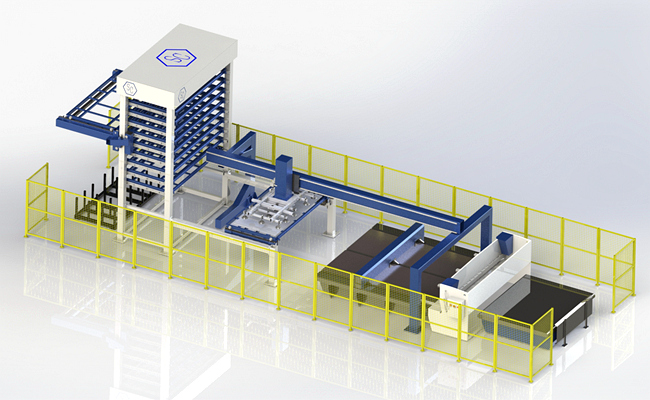
1. Material Storage
Metal automation loading and unloading system has the metal storage system. It has the simple metal palletizing platform or it can connect with the metal automatic storage system. Material storage systems are used to organize and store raw materials in a manner that facilitates easy access and handling. These systems can be simple racks or advanced automated storage and retrieval systems (AS/RS) that integrate with the laser cutting machine.
- Racks and Shelving: Basic storage solutions that allow operators to manually retrieve materials.
- Automated Storage and Retrieval Systems (AS/RS): Advanced systems that automatically store and retrieve materials based on production requirements, optimizing space and efficiency.
2. Material Handling Equipment
Material handling equipment is essential for transporting raw materials from storage to the laser cutting machine and for moving finished parts to their next destination. Common types of material handling equipment include:
- Conveyors: Belt or roller conveyors transport materials between different stages of the laser cutting process.
- Robotic Arms: Robotic arms equipped with grippers or vacuum suction devices handle materials with precision, enabling automated loading and unloading.
- Cranes and Hoists: Used for lifting and moving heavy materials, particularly in large-scale manufacturing environments.
3. Loaders and Unloaders
Loaders and unloaders are specialized machines designed to automate the process of placing raw materials onto the laser cutting machine and removing finished parts. These systems can be integrated with other automation equipment to create a seamless material handling process.
- Sheet Loaders: Automatically load sheets of material onto the laser cutting machine, reducing manual effort and increasing efficiency.
- Part Unloaders: Automatically remove finished parts from the cutting bed, ensuring smooth and continuous operation.
4. Control Systems
Control systems manage the operation of loading and unloading equipment, ensuring precise and coordinated movement of materials. These systems can be standalone or integrated with the laser cutting machine’s CNC control.
- Programmable Logic Controllers (PLCs): PLCs are used to control the sequence of operations in automated systems, ensuring accurate and reliable performance.
- Human-Machine Interfaces (HMIs): HMIs provide operators with a user-friendly interface to monitor and control the loading and unloading process.
Benefits of Automated Loading and Unloading Systems
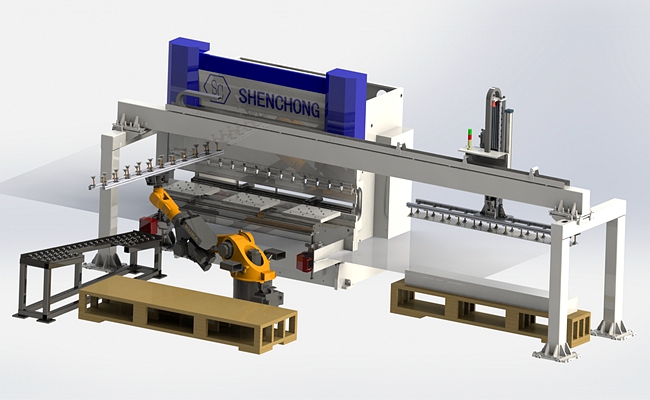
1. Enhanced Productivity
Automated metal sheet loading unloading system significantly reduces the time required for loading and unloading materials, allowing the laser cutting machine to operate continuously. This increased productivity translates into higher throughput and faster turnaround times.
2. Labor Cost Savings
By automating material handling processes, manufacturers can reduce the reliance on manual labor. This not only lowers labor costs but also minimizes the risk of human error, ensuring consistent and high-quality production.
3. Improved Safety
Automated loading and unloading systems enhance workplace safety by reducing the need for human interaction with heavy and potentially hazardous materials. This minimizes the risk of accidents and injuries, creating a safer working environment.
4. Consistency and Quality
Automation ensures consistent handling of materials, which is crucial for maintaining high-quality standards in the laser cutting process. Automated systems can precisely position materials, reducing the likelihood of misalignment and ensuring accurate cuts.
5. Space Optimization
Advanced storage and retrieval systems can optimize the use of available space, allowing manufacturers to store more materials in a smaller footprint. This is particularly beneficial in environments with limited space.
6. Flexibility
Automated systems can be programmed to handle different types of materials and part sizes, providing flexibility in production. This adaptability is essential for manufacturers that produce a variety of products or frequently change production runs.
Case Studies
1. Automotive Manufacturer
An automotive manufacturer implemented a fully automated loading and unloading system for their laser cutting machines. The system included robotic arms, conveyors, and an advanced storage and retrieval system. The result was a 40% increase in productivity, a 30% reduction in labor costs, and improved safety for operators.
2. Aerospace Component Supplier
A supplier of aerospace components integrated automated loading and unloading systems with their laser cutting machines. The systems were equipped with sensors and AI algorithms for real-time monitoring and optimization. This integration led to a 50% reduction in setup times, a 25% increase in production throughput, and enhanced quality control.
3. Electronics Manufacturer
An electronics manufacturer adopted a semi-automatic loading and unloading system for their laser cutting operations. The system featured automated tool changers and conveyors for material handling. The implementation resulted in a 35% reduction in material handling time, improved accuracy, and consistent quality in the production of electronic components.
Points To Consider Before Purchasing
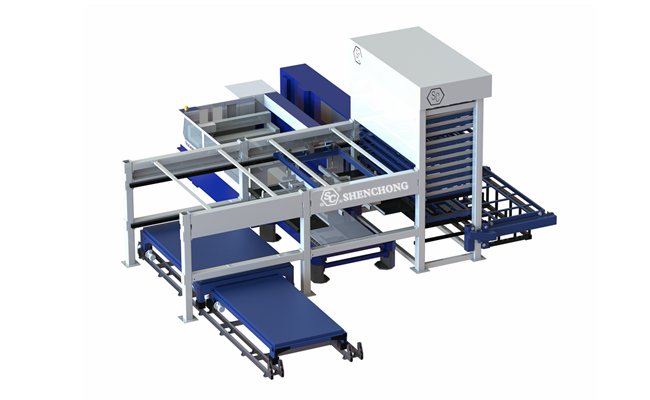
When purchasing a metal automation loading and unloading system, it’s essential to carefully consider various factors to ensure that the system meets your production requirements and long-term needs. Here are key points to evaluate.
1. Material Handling Capabilities
- Type of Metal: Ensure the system is compatible with the specific metals you work with (e.g., steel, aluminum, etc.).
- Weight and Size: Confirm the system can handle the weight, size, and thickness of the materials to be processed.
- Sheet/Part Dimensions: Make sure the system accommodates the range of dimensions your operation requires.
2. Automation Level
- Manual, Semi-Automated, or Fully Automated: Determine if you need full automation or if a semi-automated system would suffice.
- Robotics Integration: Assess whether robotic arms or other automated technologies are necessary for your specific application.
- Workflow Efficiency: Consider how automated the process should be to match your production speed and reduce downtime.
3. Capacity and Throughput
- Loading/Unloading Speed: Verify that the system can handle the throughput required to match your production pace.
- Cycle Time: Analyze the cycle times of loading and unloading operations to ensure they align with your overall production timeline.
- Batch or Continuous Loading: Depending on your production scale, determine whether a batch system or continuous loading system is more appropriate.
4. System Compatibility and Integration
- CNC/Press Integration: Ensure the system integrates well with your CNC machines, lasers, or other cutting and bending machines.
- Software Compatibility: Check if the system is compatible with your existing production management software or ERP systems.
- Automation Controls: Review the user interface and control systems for ease of use and integration with other machines in the workflow.
5. Space and Layout
- Footprint: Consider the physical space the system will occupy. Verify that it fits into your production area without disrupting workflow.
- Accessibility: Ensure the system is easily accessible for maintenance, loading raw materials, and unloading finished parts.
6. Customization Options
- Modular Design: Look for systems with modular configurations that allow for future expansion or customization based on evolving production needs.
- Tailored Solutions: Check if the supplier offers customization options based on your specific material or operational needs.
7. Safety Features
- Safety Sensors and Guards: Ensure the system has robust safety mechanisms such as emergency stop buttons, sensors, and physical guards to protect operators.
- Compliance with Standards: Verify that the system complies with local and international safety standards, such as ISO or OSHA regulations.
8. Cost and ROI
- Initial Cost: Analyze the upfront investment and compare it with the expected benefits, such as increased productivity or reduced labor costs.
- Maintenance Costs: Consider the long-term maintenance costs and spare parts availability.
- Return on Investment: Calculate the system’s ROI based on its ability to reduce labor, increase efficiency, or handle more complex tasks.
9. Maintenance and Support
- Service Contracts: Evaluate the warranty and service support provided by the manufacturer.
- Maintenance Requirements: Check how easy it is to maintain the system, the availability of spare parts, and the frequency of required maintenance.
- Training and Installation: Ensure that the supplier offers adequate training for your team and provides support during installation and setup.
10. Vendor Reputation and References
- Supplier Experience: Look into the vendor’s experience in providing automation systems for your industry.
- Customer Reviews: Consider asking for references from current users of the system to assess reliability and performance in real-world applications.
- After-Sales Support: Assess the quality of after-sales service, including technical support, response time, and availability of replacement parts.
11. Environmental Impact
- Energy Consumption: Analyze the system’s energy efficiency to keep operational costs low and minimize environmental impact.
- Noise Levels: Consider noise reduction features if your production environment has noise level constraints.
Evaluating these factors carefully will help you select a system that fits your production requirements, boosts efficiency, and provides long-term value.
Metal Sheet Loading and Unloading System Price Range
The price range for metal automation loading and unloading system can vary widely depending on factors like the system’s size, capacity, level of automation, brand, and specific features (e.g., CNC integration, robotics, and advanced safety features). Generally, these systems fall into the following price ranges:
- Basic Systems: For smaller or less complex setups, prices typically range from $20,000 to $50,000.
- Mid-Range Systems: Systems with moderate capabilities, better automation, and integration options generally cost between $50,000 and $150,000.
- High-End Systems: Highly advanced systems with features like full automation, integrated robotics, and larger capacities can range from $150,000 to $500,000 or more.
Customization and additional features like software integration or extra safety mechanisms can also affect pricing. For a specific quote, reaching out to suppliers would provide a more accurate figure tailored to your needs.
Future Trends in Loading and Unloading Systems
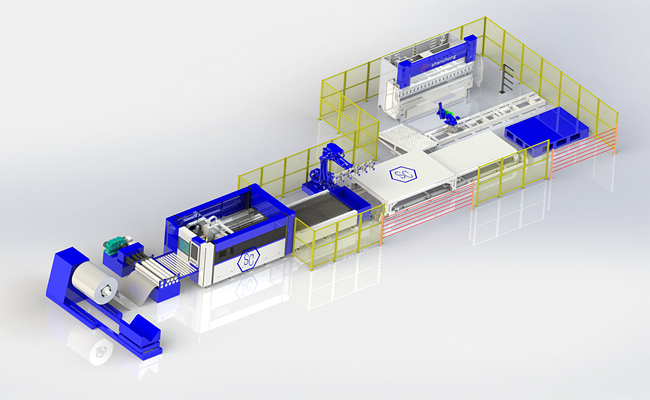
1. Integration with Industry 4.0
The integration of loading and unloading systems with Industry 4.0 technologies, such as the Internet of Things (IoT), artificial intelligence (AI), and machine learning, is set to revolutionize material handling. These technologies enable real-time monitoring, predictive maintenance, and data-driven decision-making, enhancing the efficiency and reliability of automated systems. To connect with other automation units such as metal automatic storage system, robotic press brake, uncoiling and leveling laser cutting machine, sheet metal processing factory can integrate sheet metal automation production lines.
2. Advanced Robotics
Advancements in robotics are driving the development of more sophisticated and capable automated systems. Collaborative robots (cobots) that can work alongside human operators, and autonomous mobile robots (AMRs) that navigate and transport materials independently, are becoming increasingly prevalent.
3. Enhanced Flexibility
Future metal sheet automatic loading and unloading systems will offer greater flexibility, allowing manufacturers to easily switch between different materials and part sizes. Modular and reconfigurable systems will enable quick adaptation to changing production requirements.
4. Energy Efficiency
As sustainability becomes a priority, metal loading and unloading systems will be designed with energy efficiency in mind. Innovations such as energy-efficient motors, regenerative braking systems, and smart energy management will reduce the environmental impact of automated material handling.
5. Improved User Interfaces
User-friendly interfaces and intuitive control systems will enhance the ease of use and accessibility of automated loading and unloading systems. Advanced HMIs and augmented reality (AR) interfaces will provide operators with real-time information and guidance, improving overall efficiency.
Conclusion
Metal automation Loading and unloading system for laser cutting machines are crucial components that enhance productivity, reduce labor costs, and improve safety in manufacturing environments. From manual to fully automated systems, these technologies offer a range of solutions to meet the diverse needs of different industries. As advancements in robotics, AI, and Industry 4.0 technologies continue to evolve, the future of automated material handling looks promising, offering even greater efficiency, flexibility, and sustainability.
Manufacturers that invest in advanced loading and unloading systems can expect significant improvements in their production processes, enabling them to stay competitive in an increasingly demanding market. By understanding the benefits, applications, and future trends of these systems, businesses can make informed decisions and leverage the full potential of their laser cutting operations.
